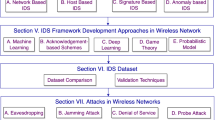Abstract
There is considerable interest in modeling the performance of ad hoc networks analytically. This paper presents approximate analytical models for the throughput performance of single-hop and multi-hop ad hoc networks. The inherent complexity of analysis of a multi-hop ad hoc network together with the fact that the behavior of a node is dependent not only on its neighbors' behavior, but also on the behavior of other unseen nodes makes multi-hop network analysis extremely difficult. However, our approach in this paper to analyze multi-hop networks offers an accurate approximation with moderate complexity. Our approach is based on characterizing the behavior of a node by its state and the state of the channel it sees. This approach is used to carry out an analysis of single-hop and multi-hop ad hoc networks in which different nodes may have different traffic loads. In order to validate the model, it is applied to IEEE 802.11-based networks, and it is shown through extensive simulations that the model is very accurate.
Similar content being viewed by others
References
G. Bianchi, Performance analysis of the IEEE 802.11 distributed coordination function, IEEE JSAC 18(3) (2000) 535–547.
F. Cali, M. Conti and E. Gregori, Dynamic tuning of the IEEE 802.11 protocol to achieve a theoretical throughput limit, IEEE/ACM Trans. on Networking 8(6) (2000) 785–799.
F. Eshghi and A.K. Elhakeem, Performance analysis of ad hoc wireless LAN for real time traffic, IEEE JSAC 21(2) (2003) 204–215.
IEEE standard, Wireless LAN medium access control (MAC) and physical layer (PHY) specifications, IEEE standard 802.11, 1997 (1999).
F. Tobagi, Modeling and performance analysis of multihop packet radio networks, Proc. of the IEEE 75(1) (1987) 135–155.
F. Tobagi and L. Kleinrock, Packet switching in radio broadcast channels: Part II-hidden terminal problem in carrier sense multiple access and the busy tone solutions, IEEE Trans. on Commun 23(12) (1975) 1417–1433.
Z. Haas and J. Deng, Dual busy tone multiple access (DBTMA) - A multiple access control scheme for Ad hoc networks, IEEE Trans. on Commun. 50(6) (2002) 975–985.
L. Kleinrock and J. Silvester, Optimum transmission radii for packet radio networks, IEEE National Telecommunication Conference (1978) 4.3.1–4.3.5.
L. Wu and P. Varshney, Performance analysis of CSMA and BTMA protocols in multi-hop networks(I). Single channel case, Information Sciences, Elsevier Sciences Inc. 120 (1999) 159–177.
Y. Wang and J.J. Garcia-Luna-Aceves, Collision avoidance in multi-hop ad hoc networks, IEEE Int'l Symp. on MASCOTS'02 (Oct. 2002) pp. 145–154.
Z. Kong, D.H.K. Tsang, B. Bensaou and D. Gao, Performance analysis of IEEE 802.11e contention-based channel access, IEEE JSAC, 22(10) (2004) 2095–2106.
E. Ziouva and T. Antonakopoulos, The IEEE 802.11 distributed coordination function in small scale ad-hoc wireless LANs, International Journal of Wireless Information Networks 10(1) (2003) 1–15.
Author information
Authors and Affiliations
Corresponding author
Additional information
Farshid Alizadeh-Shabdiz received his B.Sc. in 1989 at University of Science and Technology, M.Sc. in 1991 at Tehran University, Iran, and D.Sc. in 2004 at the George Washington University. He is a senior research engineer in Advanced Solution Group, part of Cross Country Automotive Services, and he is also a part time faculty member at Boston University.
Dr. Alizadeh-Shabdiz was part of the design and implementation team of the three first satellite-based mobile networks: ICO global medium orbit satellite network voice and data services, Thuraya GEO satellite network, and the first phase of Inmarsat high speed data network. His research interests include MAC layer, physical layer and network layer of wireless and satellite networks.
Suresh Subramaniam received the Ph.D. degree in electrical engineering from the University of Washington, Seattle, in 1997. He is an Associate Professor in the Department of Electrical and Computer Engineering at the George Washington University, Washington, DC. His research interests are in the architectural, algorithmic, and performance aspects of communication networks, with particular emphasis on optical and wireless ad hoc networks.
Dr. Subramaniam is a co-editor of the books “Optical WDM Networks – Principles and Practice” and “Emerging Optical Network Technologies: Architectures, Protocols, and Performance”. He has been on the program committees of several conferences including Infocom, ICC, Globecom, and Broadnets, and served as TPC Co-Chair for the 2004 Broadband Optical Networking Symposium. He currently serves on the editorial boards of Journal of Communications and Networks and IEEE Communications Surveys and Tutorials. He is a co-recipient of the Best Paper Award at the 1997 SPIE Conference on All-Optical Communication Systems.
Rights and permissions
About this article
Cite this article
Alizadeh-Shabdiz, F., Subramaniam, S. Analytical Models for Single-Hop and Multi-Hop Ad Hoc Networks. Mobile Netw Appl 11, 75–90 (2006). https://doi.org/10.1007/s11036-005-4462-4
Published:
Issue Date:
DOI: https://doi.org/10.1007/s11036-005-4462-4




